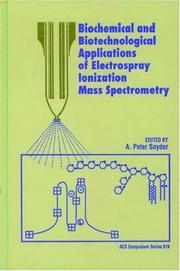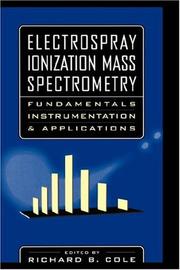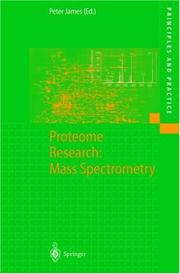| Listing 1 - 8 of 8 |
Sort by
|
Book
ISBN: 9780471741077 0471741078 Year: 2010 Publisher: Hoboken: Wiley,
Abstract | Keywords | Export | Availability | Bookmark
 Loading...
Loading...Choose an application
- Reference Manager
- EndNote
- RefWorks (Direct export to RefWorks)
Book
ISBN: 0841215553 Year: 1996 Publisher: Washington, District of Columbia : American Chemical Society,
Abstract | Keywords | Export | Availability | Bookmark
 Loading...
Loading...Choose an application
- Reference Manager
- EndNote
- RefWorks (Direct export to RefWorks)
Electrospray ionization mass spectrometry --- Biomolecules --- Analysis
Book
ISBN: 9780854041299 085404129X Year: 2009 Publisher: Cambridge : RSC,
Abstract | Keywords | Export | Availability | Bookmark
 Loading...
Loading...Choose an application
- Reference Manager
- EndNote
- RefWorks (Direct export to RefWorks)

ISBN: 0841233780 9780841233782 Year: 1995 Volume: 619
Abstract | Keywords | Export | Availability | Bookmark
 Loading...
Loading...Choose an application
- Reference Manager
- EndNote
- RefWorks (Direct export to RefWorks)
Electrospray ionization mass spectrometry --- Spectrum Analysis, Mass. --- Biomolecules --- Chromatography, Liquid. --- Analysis --- Mass spectrometry --- Congresses --- Ionization --- Electrospray ionization mass spectrometry - Congresses. --- Biomolecules - Analysis - Congresses. --- Ionization. Congresses --- Mass spectrometry. Congresses --- Biomolecules. Analysis. Congresses --- Spectrum Analysis, Mass --- Chromatography, Liquid

ISBN: 0471145645 9780471145646 Year: 1997 Publisher: New York : Wiley,
Abstract | Keywords | Export | Availability | Bookmark
 Loading...
Loading...Choose an application
- Reference Manager
- EndNote
- RefWorks (Direct export to RefWorks)
Comprehensive, up-to-date coverage of a revolutionary technique Electrospray ionization mass spectrometry (ESI-MS) has completely changed the way physicists, chemists, and biologists view the study of large molecules. The technique derives detailed information about molecular weights and structures from extremely small sample quantities. ESI-MS can create highly charged forms of very high molecular weight compounds, it is naturally compatible with many types of separation techniques, and it allows noncovalent interactions between molecules in solution to be preserved in the gas phase. But many researchers may not use the technique to its full potential because they are unfamiliar with the different perspectives of its underlying processes, the varied approaches to implementation, and the wide-ranging utility of the technique.In this book, Richard B. Cole and an assemblage of leading researchers present a single-volume compilation of different approaches to the understanding and exploitation of ESI-MS. This comprehensive guide:* Examines the physical and chemical aspects of the electrospray process and describes the events involved in ion formation as well as the electro-chemical phenomena that are central to charged droplet formation during the process* Explores the coupling of electrospray ionization to various mass spectrometers, including quadrupole, magnetic, time-of-flight, quadrupole ion trap, and Fourier transform ion cyclotron resonance instruments* Describes recent progress in interfacing ESI with solution-based separation techniques, including liquid chromatography and capillary electrophoresis* Charts the rapid development of ESI applications and categorizes them by compound type: peptides and proteins, nucleic acids and their constituents, carbohydrates and lipids, small molecules related to pharmacology and drug metabolism, and organometallics and inorganic compoundsElectrospray Ionization Mass Spectrometry is the indispensable handbook and refer
Spectrometric and optical chemical analysis --- fysicochemie --- Electrospray ionization mass spectrometry. --- Biomolecules --- Analysis. --- 543.51 --- -Electrospray ionization mass spectrometry --- #WSCH:MACC --- ESIMS (Spectrum analysis) --- Ionization mass spectrometry, Electrospray --- Mass spectrometry --- Biological molecules --- Molecules --- Molecular biology --- Positive ray analysis. Mass spectrometry --- Analysis --- Basic Sciences. Chemistry --- Biochemistry --- Proteins and Enzymes --- Proteins and Enzymes. --- 543.51 Positive ray analysis. Mass spectrometry --- Electrospray ionization mass spectrometry --- Biomolecules - Analysis

ISBN: 3540672559 3540672567 3642568955 9783540672555 Year: 2001 Publisher: Berlin : Springer,
Abstract | Keywords | Export | Availability | Bookmark
 Loading...
Loading...Choose an application
- Reference Manager
- EndNote
- RefWorks (Direct export to RefWorks)
Recent advances in large-scale DNA sequencing technology have made it possible to sequence the entire genome of an organism. Attention is now turning to the analysis of the product of the genome, the proteome, which is the set of proteins being expressed by a cell. Two-dimensional gel electrophoresis can be used to create cellular protein maps which give a quantitative and qualitative picture of the proteome. Mass spectrometry is the method of choice for the rapid large-scale idenfification of these proteomes and their modifications. An understanding of these methods is critical for scientists in the "Post-Genome" era.
Proteins --- Analysis --- Cancer research. --- Cell biology. --- Human Genetics. --- Cancer Research. --- Spectrometric and optical chemical analysis --- fysicochemie --- Analytical biochemistry --- Mass spectrometry. --- Analysis. --- Proteomics. --- Human genetics. --- Biotechnology. --- Molecular biology. --- Cell Biology. --- Molecular Medicine. --- Cancer research --- Molecular biochemistry --- Molecular biophysics --- Biochemistry --- Biophysics --- Biomolecules --- Systems biology --- Chemical engineering --- Genetic engineering --- Genetics --- Heredity, Human --- Human biology --- Physical anthropology --- Cell biology --- Cellular biology --- Biology --- Cells --- Molecular biology --- Proteins - Analysis --- PROTEOME --- QUADRUPOLE MASS SPECTROMETRY --- ION TRAP MASS SPECTROMETRY --- ELECTROSPRAY IONIZATION MASS SPECTROMETRY --- TIME-OF-FLIGHT MASS SPECTROMETRY --- LASER DESORPTION MASS SPECTROMETRY --- MATRIX-ASSISTED LASER DESORPTION IONIZATION MASS SPECTROMETRY --- PROTEINS --- PEPTIDES --- TANDEM MASS SPECTROMETRY --- ANALYSIS
Book
ISBN: 303897417X 3038974161 Year: 2019 Publisher: MDPI - Multidisciplinary Digital Publishing Institute
Abstract | Keywords | Export | Availability | Bookmark
 Loading...
Loading...Choose an application
- Reference Manager
- EndNote
- RefWorks (Direct export to RefWorks)
Sterols and other isoprenoids are of great interest for their molecular structure and function in cell architecture and evolution, as well as for their importance in medicine and agriculture. Molecules’ 2019 Festschrift Special Issue in honor of the 65th birthday of Prof. W. David Nes, an internationally recognized chemical biologist and recipient of the George Schroepher medal for sterol research, focuses on recent developments in the chemistry, biosynthesis, and function of these polycyclic natural products. This volume of Molecules contains 16 leading-edge review articles and original research contributions from an international cast of scientists. This volume is grouped into three sections: (i) isoprenoid metabolome and diversity, (ii) clinical evaluation of sterol and triterpene structures and biosynthesis, and (iii) methods and synthesis of steroids and other compounds. The volume will be a valuable reference tool for those who study medicinal chemistry, protein chemistry, and biochemistry of isoprenoid lipids.
high-fat high-carbohydrate diet --- toxicity --- oxysterol --- n/a --- squalene cyclase --- sterol content --- sterolomics --- Polystichum --- Smith-Lemli-Opitz syndrome --- antifungals --- alkaloid --- cycloartenol synthase --- degeneration --- phytosterol --- Rhizopus arrhizus --- fibroblasts --- pod-blast --- fern --- cholesterol --- cytotoxic activity --- N-methylpiperidine. reductive deamination --- genetic disease --- isoprenoid --- steroid --- atherosclerosis --- granatane --- antioxidant --- wound healing --- development --- enzyme-assisted derivatization --- maturity --- terpene --- keratinocytes --- C4-demethylation complex (C4DMC) --- ?-sitosterol --- mesocarp --- sterol biosynthesis --- mechanism-based inactivators --- Mucorales --- gas chromatography-mass spectrometry (GC-MS) --- Girard reagent --- ROS --- sterol pattern --- N-methylcadaverine --- ?-tocopherol --- electrospray ionization-mass spectrometry --- human African trypanosomiasis --- HUVECs --- lipidomics --- campesterol --- triterpene --- oxyphytosterol --- leishmania --- Chagas disease --- LOX-1 --- sterol C24-methyltransferase --- antifungal effectivity --- ergosterol biosynthesis --- hormone --- glucose homeostasis --- retina --- solanaceae --- cholestanoic acid --- algal sterols --- cell migration --- withanolides --- insulin resistance --- Zingiber officinale --- posaconazole --- synthesis --- pre-diabetes --- pharmacognosy --- sterol --- 4-methylsterol --- oleanolic acid --- antiparasitic drugs --- lupeol --- oilseed --- aurelianolides --- divalent metal co-factor ligation --- bile alcohol --- phytosterols --- azoles --- infectious disease --- gingerols --- UV-radiation --- oil bodies --- ZnO --- sterol 14?-demethylase --- stigmasterol
Book
ISBN: 3039210858 303921084X Year: 2019 Publisher: MDPI - Multidisciplinary Digital Publishing Institute
Abstract | Keywords | Export | Availability | Bookmark
 Loading...
Loading...Choose an application
- Reference Manager
- EndNote
- RefWorks (Direct export to RefWorks)
The present Special Issue, “Innovative Extraction Techniques and Hyphenated Instrument Configuration for Complex Matrices Analysis”, aims to collect and to disseminate some of the most significant and recent contributions in the interdisciplinary area of innovative extraction procedures from complex matrices followed by validated analytical methods using hyphenated instrument configurations to support the optimization of the whole process and the scale-up possibility
alginate --- n/a --- heavy metals --- high-speed counter-current chromatography (HSCCC) --- microwave processing --- phytochemicals --- microNIR --- antioxidant activity --- in-line monitoring --- Wuyi Rock tea --- metabolomics --- seawater --- optimization --- walnut septum --- color analysis --- metabolite profiling --- rosuvastatin --- dispersive liquid-liquid microextraction --- antioxidant --- mouse melanoma B16 cells --- nails --- extraction --- sample preparation --- quality --- MAE --- Panax notoginseng --- physicochemical properties --- flow injection --- ionic liquids --- branched-chain keto acids --- Semen Cuscutae --- near-infrared spectroscopy --- volatile organic compounds --- odor --- SFE --- single-drop microextraction --- experimental design --- cluster analysis --- therapeutic drug monitoring --- Thymus algeriensis --- metformin --- tyrosinase --- gas chromatography-olfactometry --- Ajuga genevensis --- phytosterols --- serum --- diabetes --- GHB --- polyphenols --- ultrasound assisted extraction --- microextraction --- oolong tea --- alkaloid --- minor ginsenosides --- inductively coupled plasma-mass spectrometry --- wood --- stir bar sorptive extraction --- HPLC-Q-TOF/MS --- GHB glucuronide --- Hericium erinaceuns mycelium --- endogenous values --- cultivars --- Tieguanyin tea cultivar --- SIRT1 --- modification --- HPLC-MS/MS --- fluid bed process --- steamed Panax notoginseng --- dry extract --- UPLC-QTOF MS --- flavonoids --- blood-enriching activity --- UPLC-QqQ MS --- HPLC-PDA --- neurodegenerative disease --- biological activity --- rare earth elements --- response surface methodology --- solid-phase microextraction --- Ultra-Turrax extraction --- bovine hide --- ultra-high-performance liquid chromatography tandem mass spectrometry --- gel strength --- hematopoiesis --- genistein --- muscle --- Lycium ruthenicun --- hemostatic activity --- flavonoid --- ultra-high-performance liquid chromatography coupled to electrospray ionization mass spectrometry --- HILIC --- surfactant --- saponins --- pigments --- chlorogenic acids --- daidzein --- Fe3O4 --- LC-MS --- Asphodeline lutea --- actinidin --- total polyphenolic content --- stir cake sorptive extraction --- gelatin --- ruthenicunoid A
| Listing 1 - 8 of 8 |
Sort by
|

 Search
Search Feedback
Feedback About UniCat
About UniCat  Help
Help News
News